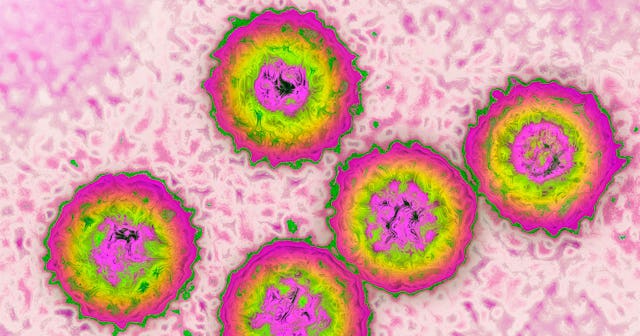CMV Is A Common Virus, But Presents Major Concerns For Pregnant People

When I became pregnant with my first child, my doctor sat me down and told me what I needed to know in order to ensure a safe pregnancy. She told me the dos and the don’ts. Mostly don’ts. Don’t drink alcohol, don’t smoke, don’t eat sushi, don’t drink too much coffee, don’t eat cold cuts. She explained the prenatal screenings and periodic ultrasounds.
But she didn’t cover everything. She never mentioned Congenital Cytomegalovirus, or CMV, even though, it is “the most common viral infection, and the leading non-genetic cause of hearing loss, that infants are born with in the United States,” according to the National CMV Foundation.
Until recently, I’d never heard of CMV. That’s not surprising. 91 percent of women do not know about CMV, despite the fact that over half of people worldwide (men and women) are infected with CMV by the time they’re 40. The prevalence of CMV combined with its relative obscurity inspired Moderna to host a webinar aimed at raising awareness of CMV.
What Is CMV?
Shidlovski/Getty
CMV is a common virus that can infect people of all ages. It’s a virus that stays in a person’s body for life after it’s contracted.
It’s typically harmless, according to the National CMV foundation. Often a healthy individual who contracts CMV will not have any symptoms. If symptoms do develop, they are usually mild and look similar to other cold symptoms. In folks who are pregnant or immune compromised, however, the virus could have serious consequences.
“In a nutshell, CMV is common and it is complicated,” says Dr. Lori Panther, VP Clinical Development, Infectious Disease at Moderna.
What Is Congenital CMV?
When babies are infected in utero and born with CMV, it’s called Congenital CMV. Congenital CMV is the most common congenital viral infection in the United States. It affects approximately 30,000 children annually. Babies born with Congenital CMV typically appear healthy at birth. Unfortunately, twenty percent of babies born with congenital CMV will “develop permanent health problems (roughly 6,000 children) with as many as 400 infant deaths annually,” according to data from the National CMV Foundation.
The National CMV Foundation lists the following birth defects and developmental disabilities that a baby born with congenital CMV may display.
- Hearing loss (Congenital CMV is the leading non-genetic cause of hearing loss.)
- Vision loss
- Mental disability
- Microcephaly (small head or brain)
- Intracranial calcifications
- Lack of coordination
- Cerebral Palsy
- Feeding issues / Failure to Thrive (FTT)
- Sleeping, behavior, sensory issues
- Seizures
- Death (in rare cases)
What Can I Do To Prevent CMV?
Dr_Microbe/Getty
Corinne Le Goff, Moderna’s Chief Commercial Officer, noted that “awareness is the first step closer to effective change.” Which is why the first step to preventing CMV is knowing that it exists. In 2020, there were more than 400 million searches related to pregnancy. Only three million of those were related to CMV. Put in perspective that is to say that less than one percent of searches about pregnancy were related to the virus that is the leading cause of birth defects in the United States.
The next step is educating yourself on how to protect yourself from CMV, particularly if you’re of childbearing age, pregnant, or thinking of becoming pregnant. The National CMV Foundation is an excellent resource and is committed to “helping women take charge of their health before CMV has an impact on their lives and lives of their families,” according to Khaliah Fleming, MPH, MCHES, Executive Director of the National CMV Foundation.
Dr. Megan H. Pesch, MD, MS, FAAP, President Elect of the National CMV Foundation, also a physician and mother to a toddler with congenital CMV, also urges women to educate their providers about CMV.
The third step to prevent CMV infection is good hygiene, particularly for those women with a toddler at home or who work in school or day care settings. This is necessary because in the U.S., nearly one in three children are infected with CMV by the time they turn five. Hand hygiene becomes particularly important because toddlers typically will not show any symptoms of infection.
It’s particularly important to wash hands after changing diapers, wiping a child’s nose or mouth, and handling a child’s toy or pacifier. CMV is not transmitted through close contact. It’s transmitted most frequently through “direct and prolonged contact with bodily fluids, including saliva, urine, and breast milk.”
Awareness, education, and prevention is important for present and future generations. Dr. Panther emphasized that point when she said, “We owe it to future families to be aware of this issue and this disease.”
CMV is common and frightening, but also preventable. One day it may even be eliminated. Moderna, a company that everyone’s talking about because of its COVID-19 mRNA vaccine, is currently working on a mRNA vaccine to prevent CMV infection. Until one is available, however, it’s important to be informed. As the old cliché goes, knowledge is power.
This article was originally published on